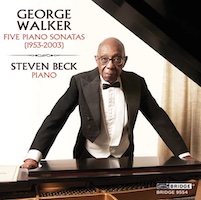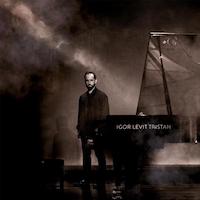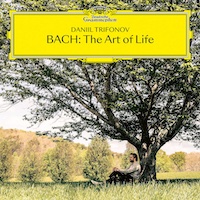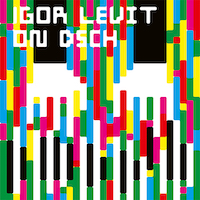Piano Factory 32.
|
Grant Chu Covell [December 2022.]
“Five Piano Sonatas (1953-2003).” George WALKER: Piano Sonata No. 1 (1953; rev. 1991); Piano Sonata No. 2 (1956); Piano Sonata No. 3 (1975; rev. 1996); Piano Sonata No. 4 (1984); Piano Sonata No. 5 (2003). Steven Beck (pno). Bridge Records 9554 (1 CD) (www.bridgerecords.com). Walker’s five lean sonatas mirror American music’s serious trends. No. 1 initiates a trajectory reflecting Boulanger’s influence, aligning with early Copland and Carter. No. 2 takes form seriously as serialism was taking shape, whereas No. 3 comes after such dodecaphonic dabbling. No. 3’s central movement, “Bell,” tells a story with the varied repetitions of one chord. I hear the last four sonatas as a connected sequence where Walker’s system appears to value compact expression over logic. In two movements, the powerful No. 4 recalls No. 1 because of its specific lines and airy clarity. Sonata No. 5 is a brief but decisive single five-minute statement written in the composer’s 80th year. The First and Second both contain movements specifically titled “Theme and Variations.” Though not labelled as such, I suspect Walker embedded elegant variations in his later sonatas. Beck navigates this music energetically and enthusiastically, serving this music well. Walker was a virtuoso pianist, and his chords and figures reward performers.
“From Afar.” J.S. BACH, Robert SCHUMANN, György KURTÁG, Béla BARTÓK, Johannes BRAHMS, Snorri Sigfús BIRGISSON, Sigvaldi KALDALÓNS, W.A. MOZART, Thomas ADÈS: Var. pieces. Víkingur Ólafsson, Halla Oddný Magnúsdóttir (pno). DG 486 1681 (2 CDs) (www.deutschegrammophon.com). Ólafsson met Kurtág in 2021 which the pianist considers a life-changing event. Understandably, DG might be hard-pressed to pitch a Kurtág-inspired program, even if swizzled with Bach, so the label appears to be emphasizing Ólafsson’s glamorousness. We should think of this recital as a friendly letter from the pianist to Kurtág. Perhaps we no longer have the capacity to listen concentratedly to Bach and must take the Leipzig master in teacups with bright aperitifs and premeditated intermezzi. As it is, Kurtág benefits from frequent allusions to Bach. For the record, Ólafsson programs predominantly restful and calming pieces by Bach, Schumann, Kurtág, Bartók, Brahms, Mozart, Adès, and two unfamiliar Icelandic composers: Snorri Sigfús Birgisson and Sigvaldi Kaldalóns. Ólafsson’s soothing sermon is delivered twice, on a standard Steinway grand and on a muffled upright whose sound sinks through the floor. It is Kurtág’s three-hand arrangement of Bach’s BWV 525, a Trio Sonata, which I return to, executed perfectly by husband-and-wife Ólafsson and Halla Oddný Magnúsdóttir. The detours to Mozart, Schumann and Brahms are welcome. Mozart’s Laudate Dominum is enormously treacly whereas Schumann’s Vogel als Prophet is uncanny, looking ahead to Scriabin. There’s a charming Ave Maria by Sigvaldi Kaldalóns, an Icelandic composer you’ve never heard of who wrote tons of tunes that became embedded in the Icelandic psyche.
“Tristan.” Franz LISZT: Liebestraum No. 3, S. 541/3 (1850); Transcendental Étude No. 11, “Harmonies du soir,” S. 139/11 (1852). Hans Werner HENZE: Tristan (1972-73)*. Richard WAGNER: Prelude to Tristan und Isolde (1857-59; arr. Zoltán KOCSIS, 1978). Gustav MAHLER: Adagio from Symphony No. 10 (1910; arr. Ronald STEVENSON, 1986; rev. 2001). Igor Levit (pno), Gewandhausorchster Leipzig*, Franz Welser-Möst* (cond.). Sony Classical 19439943482 (2 CDs) (www.sonyclassical.com). Levit steers through rocky terrain, in a program collecting musical fallout from Wagner’s Tristan und Isolde. With Henze’s esoteric Tristan at its core, love is probably not the release’s unifying subject. These pieces emphasize unconsummated emotions across a hyper-realized harmonic palette. Levit appears to enjoy this arcane collection, including two arrangements of intrinsic orchestral works. We may be expecting a chaste Liebestraum if only because it is so familiar, but Levit teases at its harmonic ambiguity and passion, illustrating that Liszt was ahead of his times. Henze’s Tristan vacillates between concerto and commentary, perhaps the recollection of a nightmare or a troubled relationship. It is prolonged, eclectic and bewildering. Henze can be a heavy orchestrator, suggesting Berg’s cinematic effects, but the tape part (a child reading a poem) over bits of the Act III Prelude comes across as corny. The late-appearing polystylism is hard to reconcile with all that comes before: Why Brahms’ First? When we finally get to Wagner’s Tristan Prelude, the feeling is relief. Finally, some familiar ambiguity. The piano approximates an orchestra, the solo echoes the Liszt we had heard before. I didn’t truck out Mahler’s score, but Stevenson’s arrangement has some surprising highlights now and again. Of course, the Tenth’s Adagio can be dissonant and an orchestra can obfuscate jarring pitches. On piano, it’s an unusual piece: a waltz rhapsody flecked with firestorms. Likewise, Kocsis’ Prelude adds bravura. Suddenly the Adagio’s viola melody or any upwards minor sixth can be traced back to Tristan und Isolde. The concluding Liszt Étude reminds us that there are few intrinsic piano pieces here. For all their bombast, Wagner and Mahler do not thrill on the keyboard the way that Liszt can.
“BACH: The Art of Life.” Johann Christian BACH: Sonata No. 5 in A major, Op. 17, No. 5 (1765). Wilhelm Friedemann BACH: Polonaise No. 8 in E minor, F. 12, No. 8 (1765). Carl Philipp Emanuel BACH: Rondo in C minor, Wq. 59, No. 4 (1785). Johann Christoph Friedrich BACH: Allegretto con variazioni (“Ah, vous dirai-je, maman”), HW XII/2 (ca. 1790). Johann Sebastian BACH, Christian PETZOLD, C.P.E. BACH and Gottfried Heinrich STÖLZEL: Selections from Notebook for Anna Magdalena Bach (1725). J.S. BACH: Chaconne from Partita No. 2 in D minor, BWV 1004 (1717-20; arr. Johannes BRAHMS as Study No. 5, 1877); The Art of Fugue, BWV 1080 (1749); Jesu, Joy of Man’s Desiring from Herz und Mund und Tat und Leben, BWV 147 (1723; arr. Mrya HESS). Daniil Trifonov (pno). DG 00028948385300 (2 CDs) (www.deutschegrammophon.com). Trifonov takes his sweet time leafing through this sprawling family album. He’s exceedingly Romantic: W.F. Bach’s Polonaise could be a spaceship from a later century; Brahms’ arrangement of the violin Chaconne looms giddy and monumental. Following the perennial Bist du bei mir, there is the suggestion that the Chaconne hides a story, or at least a tune. With a few familiar minuets and other beginners’ pieces from the Anna Magdalena Bach Notebook (sometimes including elaboration on repeats as in BWV Anh 128) and a lean but brisk The Art of Fugue, Trifonov puts Bach’s alpha and omega on display. I have probably never heard Petzold (to whom a particularly ubiquitous Minuet is now attributed) and the late great Contrapuncti on the same program. Trifonov assuredly leans towards rubato, even hammy expression. His completion of the unfinished fugue is grand, however, capping the program with a cloying Jesu discards the solemnity with a wink and a grin.
“On DSCH.” Dmitri SHOSTAKOVICH: 24 Preludes and Fugues, Op. 87 (1950-51). Ronald STEVENSON: Passacaglia on DSCH (1960-63). Igor Levit (pno). Sony Classical 19439809212 (3 CDs) (www.sonyclassical.com). It’s easy for us armchair mortals to point out the similarities between Shostakovich’s Fugues. They can blur together despite the Preludes’ varied moods. Nonetheless, if Shostakovich wrote this for himself during dark times, these 48 pieces make it clear that outside of grandiose or cryptic statements, Shostakovich was profoundly accomplished. But it’s still a large landscape to trudge through. Might someone play the whole series in concert? A recording enables passing through rather than enduring. Stevenson’s bluntly gigantic Passacaglia is meant for a single sitting, despite the churning waves and how the recurring passacaglia theme and its harmonic shape can irritate not unlike minimalism. If Shostakovich was using preludes and fugues to express his feelings about his world, Stevenson employs the D-S-C-H figuration as a foundation to comment upon current events, visiting his native Scotland, Africa and of course Stalinist Russia. The thunderous conclusion unleashes a triple fugue incorporating the D-S-C-H motive, the B-A-C-H figuration and the Dies Irae. It’s an unexpected relief to hear a new tune, the Dies Irae, so late in the game. Overall, it’s a grandiose monument well-suited to Levit’s skills. By accident, I once shuffled the 69 tracks. The result was undeniably grotesque, but Stevenson has internalized Shostakovich’s style so that there are pervasive similarities (for example, the flickering grace notes in the Minuet from the Suite in Part I, and the D Major Prelude, Op. 87, No. 5).
Adès, Bach, Bartók, Birgisson, Brahms, CPE Bach, Henze, Hess, JC Bach, JCF Bach, Kaldalóns, Kocsis, Kurtág, Liszt, Mahler, Mozart, Petzold, Schumann, Shostakovich, Stevenson, Stolzel, Wagner, Walker, WF Bach
[More Grant Chu Covell, Piano Factory]
[More
Adès, Bach, Bartók, Birgisson, Brahms, CPE Bach, Henze, Hess, JC Bach, JCF Bach, Kaldalóns, Kocsis, Kurtág, Liszt, Mahler, Mozart, Petzold, Schumann, Shostakovich, Stevenson, Stolzel, Wagner, Walker, WF Bach]
[Previous Article:
Dvořák’s Prophecy, Shostakovich as Cure and Beethoven in Boston]
[Next Article:
Used Bin Troll Tweets LLL.]
|




